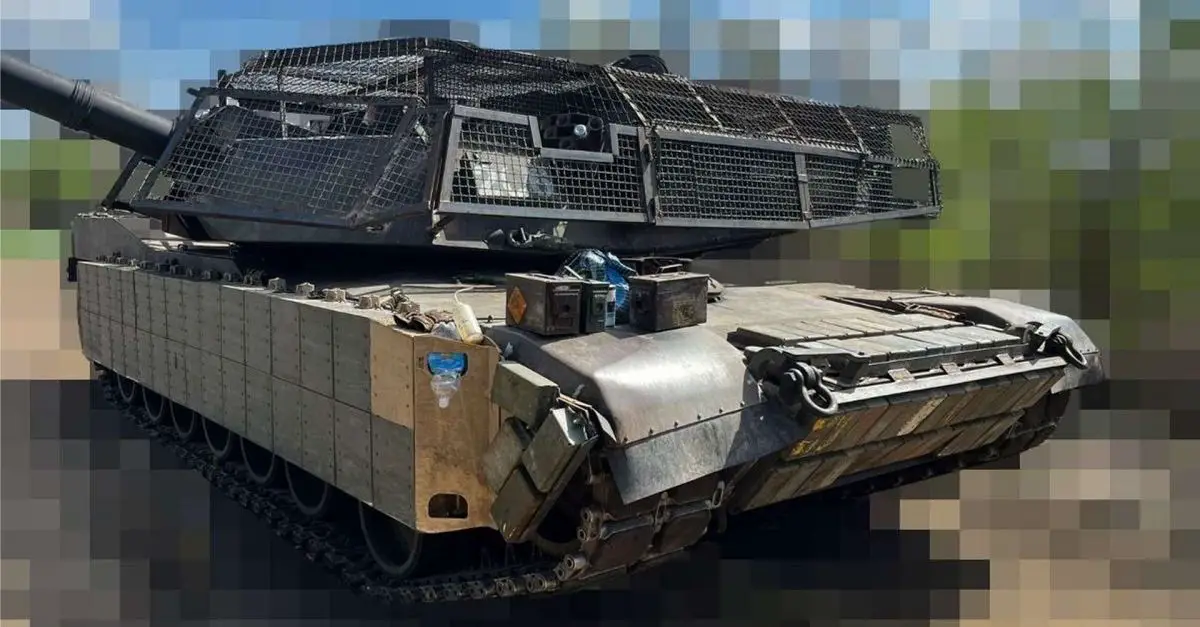Breaking news
Ukraine Increases Protection of US M1A1 Abrams Tanks to Counter Modern Missiles and Drone Top Attacks.
In response to evolving threats in the ongoing Russo-Ukrainian conflict, Ukrainian soldiers have upgraded the protection of their U.S. M1A1 Abrams tanks to counter its weaknesses on the Ukrainian battlefield. Recent pictures released on social networks reveal that the tanks are now equipped with new Explosive Reactive Armor (ERA) and a steel cage surrounding the turret. These enhancements aim to bolster the tanks' defenses against modern anti-tank missiles and drone attacks, addressing vulnerabilities that have been exposed in the conflict.
Follow Army Recognition on Google News at this link

A picture published on social media shows U.S. M1A1 Abrams tanks of the Ukrainian army fitted with Explosive Reactive Armor (ERA) and top cage armor. (Picture source: Social Network X)
The M1A1 Abrams tank was developed in the 1980s as an upgrade to the original M1 Abrams, which had entered service in 1980. This upgraded version, featuring a more powerful 120mm smoothbore gun, improved armor, and several other enhancements, was designed to meet evolving battlefield requirements. The M1A1 Abrams entered service with the United States Army in 1985.
Despite its formidable design, the M1A1 Abrams tank faces several vulnerabilities, especially in the context of modern warfare as seen in the Russo-Ukrainian conflict. One significant threat comes from modern anti-tank guided missiles (ATGMs). The proliferation of advanced ATGMs, such as the Russian Kornet, poses a substantial risk as these missiles are designed to penetrate even composite and reactive armor, challenging the Abrams' defenses.
Additionally, the rise of First-Person View (FPV) drones and kamikaze drones introduces a new dimension of threats. These drones can target tanks from above, aiming for less protected areas such as the turret top and engine deck, where traditional armor is thinner. The ability of drones to strike from unconventional angles makes them particularly dangerous.
The additional ERA (Explosive Reactive Armor) is designed to offer increased defense against modern anti-tank missiles, enhancing the tanks' survivability on the battlefield. This type of armor works by exploding on impact, thereby disrupting the penetrating force of incoming projectiles.
In addition to ERA, the Ukrainian military has also installed a steel cage around the turret. This modification aims to counter threats from First-Person View (FPV) drone attacks and kamikaze munitions, which have become increasingly prevalent in the conflict. The steel cage acts as a physical barrier, intended to intercept and neutralize these aerial threats before they can reach the tank's vital components.
These enhancements underscore the dynamic nature of modern warfare, where both offensive and defensive technologies continually evolve. The Ukrainian forces' proactive measures reflect their commitment to adapting to new challenges and protecting their personnel and equipment in a highly contested environment.
The conflict in Ukraine has seen a variety of advanced technologies deployed by both sides, making continuous adaptation a necessity. As the situation develops, further modifications and innovations in military hardware can be expected.
The experience of the war in Ukraine has highlighted the evolving nature of modern battlefield threats, emphasizing the need for continuous innovation in tank protection. To address these challenges, the U.S. defense industry must develop new solutions to enhance the survivability of modern main battle tanks (MBTs) like the M1A1 Abrams. This includes advancements in armor technology to counter advanced anti-tank missiles, improved defenses against drone attacks, and robust measures to safeguard electronic systems from cyber and electronic warfare. By investing in these areas, the U.S. can ensure that its armored forces remain resilient and effective in future conflicts.


























